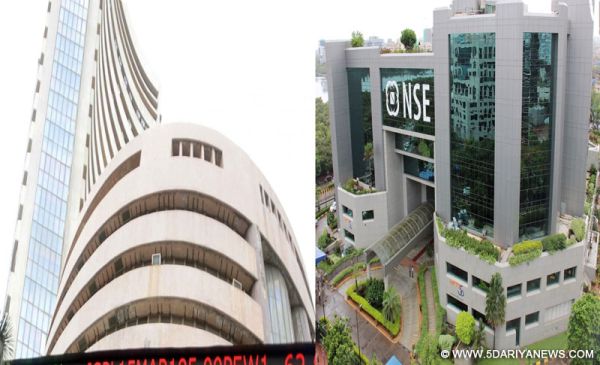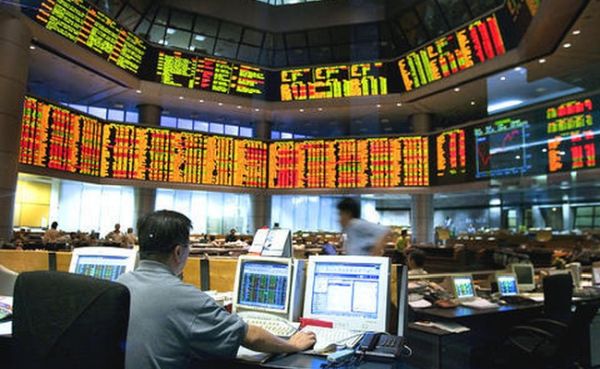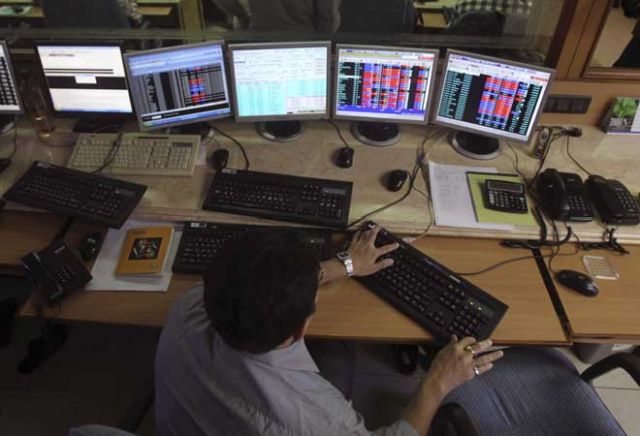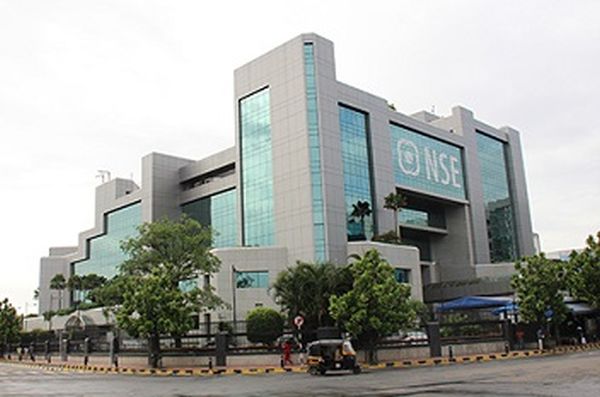
by Editor | May 25, 2021 | Banking, Economy, Markets, News
 By Ravi Dutta Mishra and Rituraj Baruah,
By Ravi Dutta Mishra and Rituraj Baruah,
Mumbai : The Indian equity market snapped its six-week-long gaining streak during the September 3-7 period as the rupee fell to record low levels, coupled with high crude oil prices and decline in the global markets.
However, gains in the indices by the end of the week helped curb losses. Three out of the five sessions were negative during the period.
The rupee breached 72 a US dollar-mark for the first time. However, towards the week-end it recovered marginally following intervention by the Reserve Bank of India (RBI), analysts said.
Investor sentiments in the global markets were subdued due to high crude oil prices and persistent US-China trade tensions.
On a weekly basis, the S&P BSE Sensex closed at 38,389.82 points, lower 255.25 points or 0.66 per cent from its previous close.
Similarly, the wider Nifty50 on the National Stock Exchange on Friday ended at 11,589.10 points, down 91.4 points or 0.78 per cent from the previous week’s close.
Heavy selling pressure was witnessed from Foreign Institutional Investors (FIIs) both in cash and futures segments, said Rahul Sharma, Senior Research Analyst at Equity99.
However, towards the fag-end of the week, market recovered from early losses. Domestic indices rose for the second consecutive session on Friday on gains in auto, metal and technology stocks, according to Prateek Jain, Director, Hem Securities.
Value buying and recovery in the rupee from its lows in the later part of the week helped the indices rise on Thursday and Friday, thereby partially paring weekly losses.
Auto stocks gained after Union Transport Minister Nitin Gadkari on Thursday announced that the government would do away with permits for commercial vehicles run on alternative fuels.
On the currency front, the rupee touched a record low of 72.11 per US dollar on Thursday, though it recovered to end the week at 71.73 per dollar — 73 paise weaker from the previous week’s close of 71 per dollar.
The rupee remained subdued for most of the week due to a rise in crude oil prices and a similar weak trend among its global peers.
In terms of investments, provisional figures from the stock exchanges showed that foreign institutional investors sold scrips worth Rs 789.60 crore and the domestic institutional investors bought stocks worth Rs 1,167.85 crore in the past week.
Figures from the National Securities Depository Ltd (NSDL) showed that foreign portfolio investors (FPIs) divested Rs 504.03 crore, or $70.06 million in the equities segment during September 3-7.
Sector-wise, the top gainers during the week were pharma, IT, metal and energy indices and the major losers were public sectors, FMCG and media indices, said Deepak Jasani, Head of Retail Research at HDFC securities.
The top weekly Sensex gainers were Wipro (up 7.43 per cent at Rs 324.05), Bajaj Auto (up 6.47 per cent at Rs 2,924), Tata Motors (DVR) (up 4.11 per cent at Rs 148.05), Tata Motors (up 3.89 per cent at Rs 277.50) and Reliance Industries (up 2.88 per cent at Rs 1,276.75 per share).
The major losers were Hindustan Unilever (down 7.96 per cent at Rs 1,638.95), Yes Bank (down 5.81 per cent at Rs 323.45), State Bank of India (down 5.50 per cent at Rs 291.85), ONGC (down 4.33 per cent at Rs 172.15) and Maruti Suzuki (down 4.01 per cent at Rs 8,732.55 per share).
(Ravi Dutta Mishra can be contacted at ravidutta.m@ians.in and Rituraj Baruah can be contacted at rituraj.b@ians.in)
—IANS

by Editor | May 25, 2021 | Banking, Economy, Markets, News
 Mumbai : The key Indian equity indices ended on a negative note for the sixth consecutive trading session on Wednesday, weighed down by a plunge in the Indian rupee and broadly negative global cues.
Mumbai : The key Indian equity indices ended on a negative note for the sixth consecutive trading session on Wednesday, weighed down by a plunge in the Indian rupee and broadly negative global cues.
Globally, persistent trade tensions subdued the investor sentiments, analysts said.
In the domestic market, investor sentiment was further eroded as growth in the India’s manufacturing and service sector decelerated in August.
The Nikkei India Composite PMI Output Index, released on Wednesday, fell to 51.9 in August from July’s 21-month high of 54.1, driven by weaker growth in both the manufacturing and service sectors.
Although, both S&P BSE Sensex and the NSE Nifty50 were on the decline all through the day after opening on a positive note, they recovered sharply from the day’s lows during the last hour of trade.
Index-wise, the Nifty50 on the National Stock Exchange (NSE) closed at 11,476.95 points, lower by 43.35 points or 0.38 per cent from its previous close of 11,520.30 points.
Similarly, the barometer S&P BSE Sensex, which had opened at 38,192.95 points, closed in the negative territory. It closed at 38,018.31 points, lower by 139.61 points or 0.37 per cent from the previous close of 38,157.92 points.
The Sensex registered an intra-day high of 38,250.61 points and a low of 37,774.42 points.
In the broader markets, the S&P BSE Mid-cap fell by 0.61 per cent and the S&P BSE Small-cap ended 0.52 per cent from its previous close. The BSE market breadth was bearish with 1,784 declines against 981 advances.
“Tepid macro-economic updates coupled with renewed global trade war concerns dampened investor sentiment and infused volatility into the markets,” said Abhijeet Dey, Senior Fund Manager for Equities, BNP Paribas Mutual Fund.
He added: “Investor sentiment took a hit after data showed that India’s Services PMI had risen at a slower pace in August 2018.”
Said Deepak Jasani, Head of Retail Research at HDFC Securities: “the weakness came on the back of negative global cues as heightened worries over international trade conflicts dampened investor appetite for riskier assets.”
Major Asian markets closed on a negative note and European indices like FTSE 100, DAX and CAC 40 traded in the red, he added.
On the currency front, the Indian rupee settled at a record closing low of 71.75 against the US dollar, weaker by 17 paise than its previous close of 71.58 per greenback.
It recovered from the all-time low of 71.97 per dollar reached earlier in the day.
“The fall in the rupee intensified due to a strengthening dollar, which lifted up on fears of a Chinese slowdown and economic turbulence in emerging market economies,” said Rahul Sharma, Senior Research Analyst with Equity99.
Investment-wise, provisional data with exchanges showed that foreign institutional investors sold scrips worth Rs 383.67 crore and domestic institutional investors bought stocks worth Rs 176.95 crore.
Sector-wise, S&P BSE Healthcare index rose by 103.36 points, the auto index was up 66.80 points and the basic material index was rose by just 8.99 points from its previous close.
In contrast, the S&P BSE Consumer Durables index declined by 391.50 points, the capital goods index fell by 190.75 points and FMCG stocks ended 134.23 points lower than its previous close.
The top gainers at the Sensex were Yes Bank, up 2.93 per cent at Rs 343.90; Vedanta, up 2.27 per cent at Rs 229.55; Adani Ports, up 1.53 per cent at Rs 378.45; Wipro, up 1.44 per cent at Rs 318.05, and Sun Pharma, up 1.41 per cent at Rs 663.40 per share.
The majors losers were Hindustan Unilever, down 2.45 per cent at Rs 1,611; Bharti Airtel, down 1.36 per cent at Rs 372.60; Reliance Industries, down 1.33 per cent at Rs 1,225.80; Hero MoroCorp, down 1.18 per cent at Rs 3,148.20 per share.
—IANS

by Editor | May 25, 2021 | Economy, Markets, News
 Mumbai : Weak global cues along with a slowdown in the manufacturing sector plunged the key Indian equity indices nearly 1 per cent on Monday after the indices started the day’s trade on a sharply higher note.
Mumbai : Weak global cues along with a slowdown in the manufacturing sector plunged the key Indian equity indices nearly 1 per cent on Monday after the indices started the day’s trade on a sharply higher note.
Globally, investor sentiments were subdued owing to the concerns of escalation in the US-China trade war, according to analysts.
The Nikkei India Manufacturing Purchasing Managers’ Index was registered at 51.7 in August, compared to 52.3 in July, which further dampened the domestic sentiments.
The indices had opened sharply higher on the back of healthy April-June GDP data released last week but could not hold on to the gains.
Although the market saw a gradual decline from the highs throughout the day, a major drop in the indices occurred around the last hour of trade.
Index-wise, the Nifty50 on the National Stock Exchange (NSE) closed at 11,582.35 points, lower by 98.15 points or 0.84 per cent from its previous close of 11,680.50 points.
Similarly, the barometer S&P BSE Sensex closed in the negative territory. It had opened at 38,915.91 points, closed at 38,312.52 points, lower by 332.55 points or 0.86 per cent from the previous close of 38,645.07 points.
Volatility in the market can be gauged from the fact that it traversed from the day’s high of 38,934.35 points hit in the morning session to a low of 38,270.01 points by the end of the trade.
In the broader markets, the S&P BSE Mid-cap declined by 0.45 per cent while the S&P BSE Small-cap declined by 0.17 per cent from its previous close. The BSE market breadth was largely even with 1,399 declines and 1,351 advances.
“Trading for the week began on a positive note as key benchmark indices edged higher in early trade boosted by good first-quarter GDP data,” said Abhijeet Dey, Senior Fund Manager for Equities at BNP Paribas Mutual Fund.
However, the market finally closed the day’s trade in the red due to selling pressure, Dey added.
According to Deepak Jasani, Head of Retail of Research, HDFC Securities, the major Asian markets closed on a negative note, and the European indices like FTSE 100 and CAC 40 traded in the green.
On the currency front, the Indian rupee crashed to close at a fresh low of 71.21 against the US dollar, weaker by 21 paise weaker than its previous close of 70.99-71 per greenback.
The collapse in the Indian rupee came around the last hour of trade, after it had traded strongly than its previous close for most part of the day.
Investment-wise, provisional data with exchanges showed that foreign institutional investors sold scrips worth Rs 21.13 crore and domestic institutional investors sold stocks worth Rs 542.12 crore.
Sector-wise, the S&P BSE consumer durables index rose 85.27 points, the metal index was up 35.37 points and the telecom index rose by 6.39 points.
In contrast, the S&P BSE banking index declined by 365.55 points, the FMCG index fell by 273.04 points and auto stocks stocks ended 211.18 points lower than its previous close.
The top gainers at the Sensex were Wipro, up 2.49 per cent at Rs 309.15, Tata Motors (DVR), up 1.34 at Rs 144.10; Bajaj Auto, up 0.68 per cent at Rs 2,765.15; HDFC Bank, up 0.58 per cent at Rs 2,074.30 and Sun Pharma, up 0.57 per cent at Rs 655.95.
The majors losers were Hindustan Uniliver, down 4.58 per cent at Rs 1,699.05; Power Grid, down 2.92 per cent at Rs 194.75; Axis Bank, down 2.69 per cent at Rs 631.75; ICICI Bank, down 2.51 per cent at Rs 334.05 per share; and ITC, down 2.01 per cent at Rs 312.75 per share.
—IANS

by Editor | May 25, 2021 | Banking, Economy, Markets, News
 By Rohit Vaid,
By Rohit Vaid,
Mumbai : Escalating geo-political tensions following further trade protectionist measures, coupled with high crude oil prices and the rupee’s movement against the US dollar will determine the trajectory of the Indian equity markets in the coming week, analysts said.
According to market observers, other factors such as the direction of foreign fund flows along with healthy GDP growth numbers and the upcoming macro-data points are also expected to influence investors’ sentiments.
“The higher GDP growth rate numbers is likely to buoy the sentiments in the markets, though the infrastructure output slowed down and fiscal deficit rose,” Devendra Nevgi, Delta Global Partners Founder and Principal Partner, told IANS.
“The PMI (Purchasing Managers’ Index) and the auto numbers will be closely watched, after the higher GDP growth rate.”
Apart from last week’s GDP growth numbers, trends in global markets and the rupee’s movement against the US dollar will dictate trend of key indices.
“Macro-economic data, trend in global markets, the movement of rupee against the US dollar and crude oil price movement will dictate trend on the bourses in the near term,” SMC Investments and Advisors’ Chairman and Managing Director D.K. Aggarwal told IANS.
In recent days, geo-political developments have pulled the Indian rupee to fresh intra-day and closing lows.
On Friday, the Indian rupee plunged to over 71 — the lowest-ever mark — against the greenback, surpassing the previous record low of 70.85 to a US dollar.
The Indian currency closed last Friday’s trade at a new record low of 70.99-71 per dollar, 25 paise weaker than its previous close of 70.74 per greenback.
Rushabh Maru — Research Analyst at Anand Rathi Shares and Stock Brokers — told IANS: “Strong reading of India GDP data may provide some relief to rupee. However, any appreciation in the rupee would be temporary as importers may rush to cover their unhedged exposure on any appreciation opportunity.
“Exporters are likely to refrain from selling US dollars at this juncture as there are talks of rupee moving towards 72-73 levels.”
Besides the rupee, the direction of foreign fund flows will also set the course for the key indices.
In terms of investments, provisional figures from the stock exchanges showed that foreign institutional investors sold scrips worth Rs 2,028.47 crore during August 13-16.
“Domestic market may see some more consolidation in the near term given sharp rally in last two weeks,” said Vinod Nair, Head of Research at Geojit Financial Services.
“However, we expect the downside is limited given improvement domestic macros and revival in corporate earnings.”
Last week, firm global cues lifted the Indian equity market for the sixth consecutive week as both S&P BSE Sensex and NSE Nifty50 rose by over one per cent.
Accordingly, the S&P BSE Sensex closed at 38,645.07 points, higher 393.27 points or 1.03 per cent from its previous close.
Similarly, the wider Nifty50 on the National Stock Exchange ended last Friday’s trade session at 11,680.50 points, higher 123.40 points or 1.07 per cent from the previous week’s close.
(Rohit Vaid can be contacted at rohit.v@ians.in)
—IANS

by Editor | May 25, 2021 | Economy, Finance, Markets, News
 By Rituraj Baruah,
By Rituraj Baruah,
Mumbai : Firm global cues lifted the Indian equity market for the sixth consecutive week as both the key indices — S&P BSE Sensex and the NSE Nifty50 — rose by over one per cent during the August 27-31 period.
Accordingly, the BSE Sensex hit an all time high of 38,989.65 points and the NSE Nifty50 touched a record level of 11,760.20 points. Both, Sensex and Nifty also set new respective closing highs of 38,896.63 points and 11,738.50 points during the week.
Global investor sentiments firmed up earlier in the week as US and Mexico reached an agreement on revising the North American Free Trade Agreement enforced since 1994.
The global development strengthened sentiments as trade-war concerns have off-late heightened investment risk across the globe, analysts told IANS.
The indices, however were subdued in the later part of the week as the Indian rupee slumped to unprecedented low levels against the US dollar and the fears over US-China trade war flared.
On a weekly basis, the S&P BSE Sensex closed at 38,645.07 points, higher 393.27 points or 1.03 per cent from its previous close.
Similarly, the wider Nifty50 on the National Stock Exchange on Friday ended at 11,680.50 points, higher 123.40 points or 1.07 per cent from the previous week’s close.
“Benchmark indices gained for the sixth week in a row on favourable global cues,” said Rahul Sharma, Senior Research Analyst at Equity99.
Sharma, however added renewed US-China trade war concern capped gains.
According to Hem Securities’ Director Prateek Jain, US-China tariff war hurt the emerging markets and also pushed the rupee to an all-time low.
The Indian rupee touched a new low of 71 per dollar on Friday. It settled at 70.99-71 per greenback, around Rs 1.09 weaker than the previous week’s close of 69.91 per dollar.
In terms of investments, provisional figures from the stock exchanges showed that foreign institutional investors sold scrips worth Rs 579.20 crore and the domestic institutional investors bought stocks worth Rs 605.27 crore in the past week.
Figures from the National Securities Depository Ltd (NSDL) showed that foreign portfolio investors (FPIs) invested Rs 46.36 crore, or $6.47 million in the equities segment during August 27-31.
Sector-wise, metal, IT and pharma stocks were the top gainers while the major losers were media and energy stocks, according to Deepak Jasani, Head of Retail Research at HDFC Securities.
The top weekly Sensex gainers were Power Grid (up 5.11 per cent at Rs 200.60), Tata Steel (up 4.55 per cent at Rs 601.65), Tata Motors (up 4.50 per cent at Rs 267.10), Infosys (up 4.35 per cent at Rs 1,440) and Bharti Airtel (up 4.03 per cent at Rs 383.35 per share).
The major losers were Yes Bank (down 8.34 per cent at Rs 343.40), Reliance Industries (down 2.90 per cent at Rs 1,240.95), Asian Paints (down 1.54 per cent at Rs 1,240.95), Coal India (down 1.48 per cent at Rs 286.10) and IndusInd Bank (down 1.21 per cent at Rs 1,903.85 per share).
(Rituraj Baruah can be contacted at rituraj.b@ians.in)
—IANS

 By Ravi Dutta Mishra and Rituraj Baruah,
By Ravi Dutta Mishra and Rituraj Baruah,


